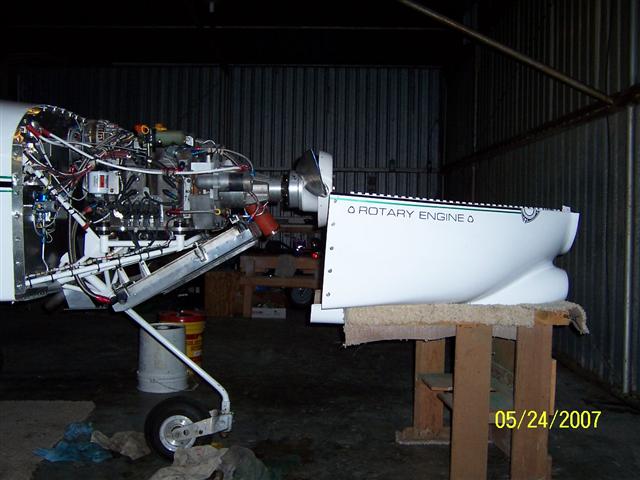Dennis, I would like to see your temps at
6500 msl and 20" Hg manifold pressure quite a bit lower. The coolant
is a bit high but acceptable for those conditions (but may not be for
other conditions) , but the oil temps is a bit on the high side to
me. When my RV-6A is operated under similar conditions, my coolant
ranges between 170-180F and oil temps the same.
However, when you say inlet temps - do you
mean inlet to your ducts or is that the inlet to your throttle body.
The reason I ask is 90F seems very high for OAT at 6500 MSL and since
you are using that figure to determine your Delta T across your cores,
you need to insure that it is correct.
Another reason I question the 90F temp is
that with a 45F temp increase across your cooler core. If we assume the
air velocity through your duct is an ideal 0.1 * Cruise speed then your
mass flow through your core with a deltaT of 45F would only remove
approx 700 BTU/Min. IF duct air velocity were 0.2*Cruise Speed then
at 45F it would remove approx 1319 BTU/Min. You don't say what your
fuel burn is so I'm assuming at 164 MPH TAS you are making at least 100
HP (probably a good deal more) which would mean you need to get rid of
a minimum of 1500 BTU/Min through your oil cooler. So since you oil
temps are a bit on the high I think it safe to say you are marginal in
getting rid of the oil BTU. But, if the OAT was 50F vice 90F then your
delta T would be 85F.
With a 0.1*cruise speed duct speed and 85F
delta T you would be getting rid of approx 1250 BTU/Min. While still a
bit on the low side probably good enough so that the excess oil BTU not
discharged by the oil cooler is being picked up by the coolant. If
your duct speed is a bit faster than my assumption then you would get
rid of more.
I found when I solved my oil temp problem
that my coolant temps came down considerably. So one system can "leak"
heat over to the other system to discharge.
So it is important that the correct inlet
temp for your ducts be used to derive your deltaT, I strongly suspect
that 90F is your throttle body inlet temp rather than your OAT at 6500
MSL.
For one thing, 4" of H20 inside the cowl does
seem a bit high but I notice it drops off to 2" H20 which is more
acceptable. But, 6.5" H20 across the core would appear to be a value
which would indicate that your duct is doing a fair job. The dynamic
pressure at 165MPH is around 10" H20. The best duct (Streamline = 0.84
Efficient) would give you around 0.84 *10"h20 = 9.155" H20. Your
6.5/10.899 = 60 % would indicate the duct is doing a fair job.
However, the cowl pressure may be lowering this value a bit.
In any case, need to know whether your inlet
to your ducts was actually 90F or was this your throttle body inlet
temp which is almost always higher than OAT.
Good work on gathering data.
Ed
-----
Original Message -----
Sent:
Saturday, September 22, 2007 11:40 PM
Subject:
[FlyRotary] RV-7A Cooling
I still working to improve my oil cooling -
Renesis engine, PSRU 2.8:1, Catto 76X88 composite prop, water and oil
radiators under engine at about 30 degrees to inlet air flow, James
cowl - shark intake under spinner . See pictures below.
Today I flew and recorded some temperature and static pressure numbers
for anyone to comment on.
Test conditions:
90 deg OAT = inlet air temperature
About 6500 foot altitude
TAS - GPS and EM-2 : 165 mph
Manifold pressure 20in.
RPM 5700
Water Temp - 192 deg F
Oil temp leaving oil cooler - 207 deg. F
Oil temp in oil pan - 235 deg. F
Temp of heated air leaving oil cooler -135 deg F (135-90 = 45 deg temp
rise of cooling air through the oil cooler)
Temp of heated air in cowl low and near firewall 133 deg. F
I measured static air pressures at 5 points inside the cowl as follows:
1). Inlet side of oil cooler: 10.5 in water
2). Back side of oil cooler: 4 in water ( 10.5 - 4 = 6.5 in water
pressure drop across oil cooler.)
3). Midway between oil cooler and firewall: 2.75 in water
4). Right side within 4 inches of firewall and 3 inches above bottom of
firewall: 2 in water
5). Left side within 4 inches of firewall and 3 inches above bottom of
firewall: 2 in water
Before these tests Bobby H. and I were thinking I needed more outlet
area to improve my cooling. I am seriously considering
a big cowl flap to lower the pressure in the cowl. Does this data
support this position?
Hopefully better minds than mine will know!!
Dennis H.

